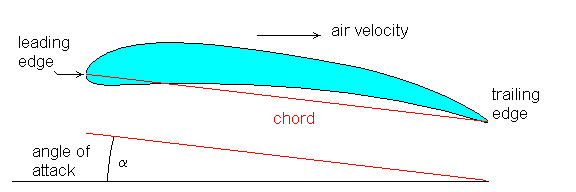
An airfoil is a two dimensional cross-section of an airplane wing. Alternatively, an airfoil can be thought of as an infinite wing of constant shape. For airfoil nomenclature see Fig. 4.2.
Figure 4.2: Airfoil nomenclature. The airfoil shown is cambered; an airfoil
without camber is called a symmetric airfoil.
The Magnus effect contains the essential ingredient for the generation of
lift by an airfoil--that ingredient is circulation of the fluid about
the airfoil. Since we are usually interested in large Reynolds number flows,
the fluid outside the boundary layer may be treated as being nonviscous.
With this assumption, it can be shown that the lift per unit length (or span) of the airfoil for a fluid with density ![]() and free stream
velocity U, with a circulation
and free stream
velocity U, with a circulation ![]() about the airfoil is
about the airfoil is
which is known as the Kutta-Joukowsky Theorem. This is identical to
the result for the cylinder, and the physics is the same. The fluid has a
higher velocity on the upper surface of the airfoil than on the lower
surface, and the pressure on the upper surface is less than that on the
lower surface, leading to lift. What determines ![]() ? For the rotating
cylinder it was simply the angular velocity of the cylinder (combined with
the viscosity of the fluid). For the airfoil the answer is not so obvious.
? For the rotating
cylinder it was simply the angular velocity of the cylinder (combined with
the viscosity of the fluid). For the airfoil the answer is not so obvious.